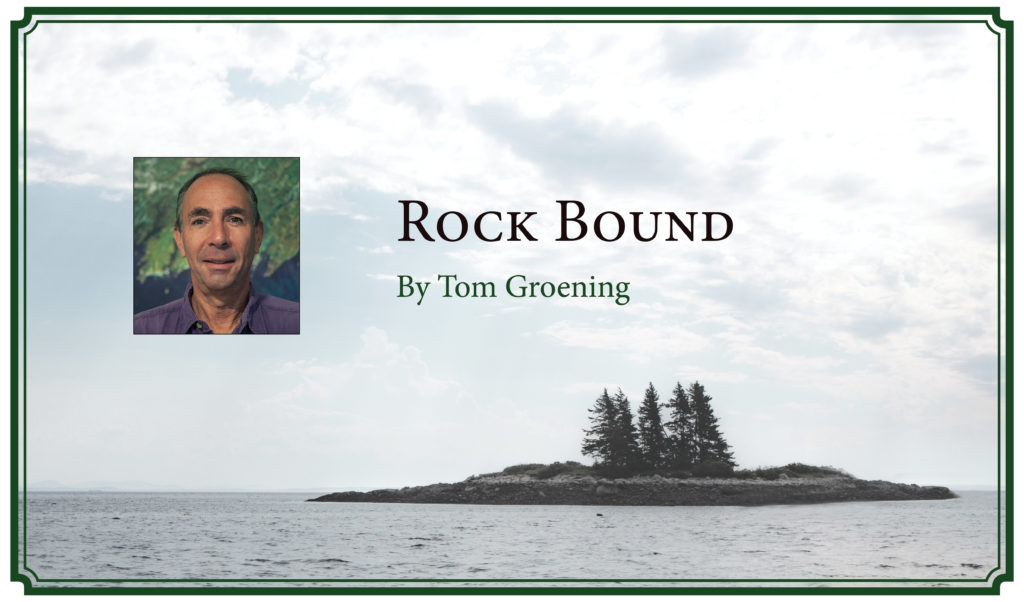By Tom Groening
Two of the most brilliant branding achievements have to be putting the word “Vacationland” on our state’s license plate, and marrying the word “Maine” to lobster.
The license plate tag, added in the 1930s, is an audacious claim. What makes Maine any more of a vacation destination than, say, Florida in the winter, the Jersey Shore in summer, or Vegas any time of the year? But the self-declared label stuck, and nearly 100 years later, we still understand ourselves and our economy through that lens.
Lobster—Homarus americanus—is no more Maine’s than it is New Hampshire’s or New Brunswick’s, but on menus at the best restaurants in New York and L.A., that delectable white meat is most effectively sold as coming from Maine. (And, for a time, we had a red—and therefore, cooked—lobster image on our license plate.)
Both tourism and lobster play outsized roles in Maine’s coastal economy. Together, they are the dominant sources of out-of-state revenue, which, of course, is the best kind of revenue. But we better not take either for granted, because threats loom, and today’s dominance can fade fast.
Maine’s tourism success comes through savvy strategic thinking and marketing, not stamped letters on a license plate. Last year’s numbers were released in April, and they remain impressive. Total visitation was at 37 million for the year, and new visitors—a key component, because research shows they tend to return again and again—was at 6.4 million. Combined lodging and restaurant sales grew to $3.4 billion.
But there are signs that healthy post-recession growth, which averaged 5 percent from 2012 to 2017, is reaching a plateau—2018 visitation was just 1.1 percent higher than that of 2017.
One threat to growth is the shortage of workers. Some hotels have kept entire wings of their buildings closed, because they can’t hire housekeepers. Restaurants, after college and high school students head back to the classroom, stop serving lunch, for lack of wait staff.
There’s also a complacency about our tourism allure that can be dangerous. That “Vacationland” tag must be earned, and the tiny Maine Office of Tourism is doing just that. The pitch these days is aimed at folks of several different generations, highlighting Maine as a place where they can carve out a self-directed, authentic interaction with our natural places and lively downtowns.
It comes at a cost, of course. But if ever there were a safe investment bet, it’s spending money on tourism promotion. Research shows a 2-1 return.
But Maine spends a pittance on promotion compared to competing states.
The lobster industry has a symbiotic relationship with tourism. Visitors love to take in the view of lobster boats bobbing at their moorings, and many seize the opportunity to enjoy a meal of the freshly caught critters.
But lobstering faces three serious threats this year. In addition to the ongoing shift of the species to the north and east, thanks to warming waters, the industry must adapt to federal efforts to protect right whales and to a much smaller herring harvest, which is the bait of choice for fishermen.
The right whale question is troubling, because it seems as if large forces—federal endangered species laws and a $500 million fishery—are headed for a collision. It’s a moral question, really. We want to save these 400 remaining North Atlantic right whales from extinction, which, sadly, rarely reach their 120-year life expectancy. But the 4,500 lobster boat captains, their families, and the communities that rely on their incomes, also must be protected.
A time-out of sorts has been called, with fishermen agreeing to remove half of their vertical lines—no small, and no cheap feat.
The bait shortage will play out differently, with access and outcomes varying, harbor by harbor. Will a smaller catch drive up prices? Will alternative baits emerge?
It’s important to remember that reliance on lobster and tourism varies widely. Places like Stonington, Vinalhaven, Rockland and Harpswell rely on lobstering. But Bar Harbor, Ellsworth, and Camden see more economic activity from tourism.
Policy makers must keep their eyes on these two economic drivers. Keeping them humming will take more than words or pictures on license plates.
Tom Groening is editor of The Working Waterfront.





